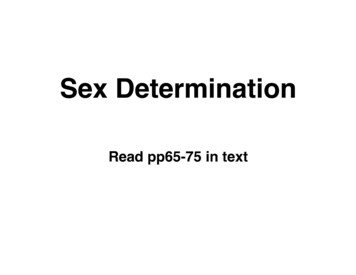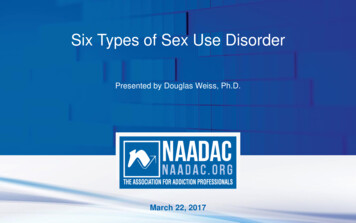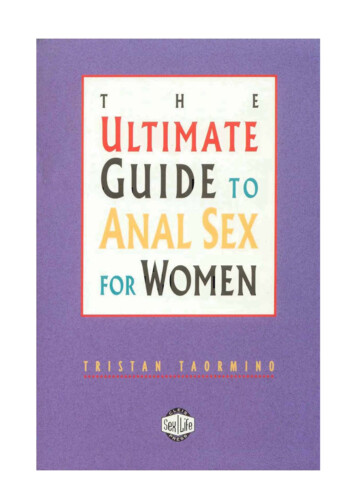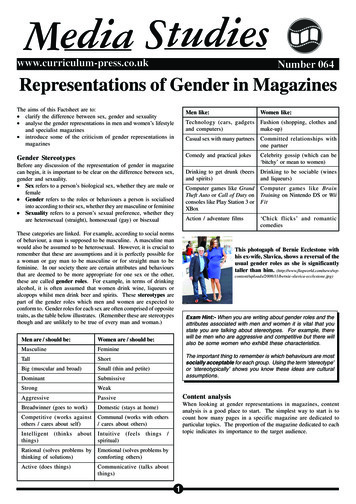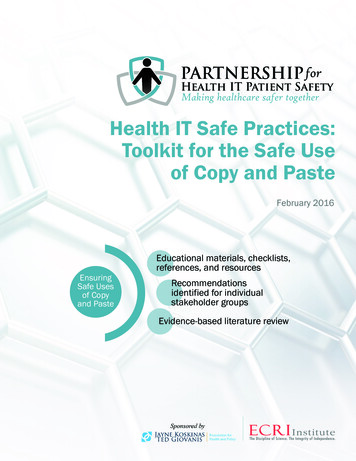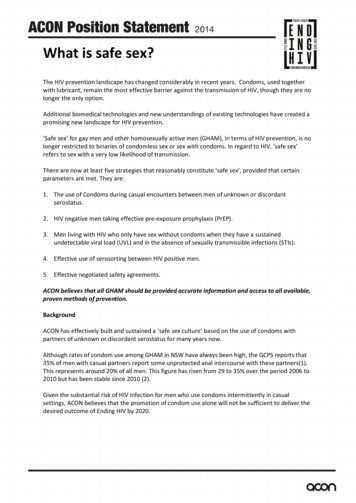
Transcription
What is safe sex?The HIV prevention landscape has changed considerably in recent years. Condoms, used togetherwith lubricant, remain the most effective barrier against the transmission of HIV, though they are nolonger the only option.Additional biomedical technologies and new understandings of existing technologies have created apromising new landscape for HIV prevention.‘Safe sex’ for gay men and other homosexually active men (GHAM), in terms of HIV prevention, is nolonger restricted to binaries of condomless sex or sex with condoms. In regard to HIV, ‘safe sex’refers to sex with a very low likelihood of transmission.There are now at least five strategies that reasonably constitute ‘safe sex’, provided that certainparameters are met. They are:1. The use of Condoms during casual encounters between men of unknown or discordantserostatus.2. HIV negative men taking effective pre-exposure prophylaxis (PrEP).3. Men living with HIV who only have sex without condoms when they have a sustainedundetectable viral load (UVL) and in the absence of sexually transmissible infections (STIs).4. Effective use of serosorting between HIV positive men.5. Effective negotiated safety agreements.ACON believes that all GHAM should be provided accurate information and access to all available,proven methods of prevention.BackgroundACON has effectively built and sustained a ‘safe sex culture’ based on the use of condoms withpartners of unknown or discordant serostatus for many years now.Although rates of condom use among GHAM in NSW have always been high, the GCPS reports that35% of men with casual partners report some unprotected anal intercourse with these partners(1).This represents around 20% of all men. This figure has risen from 29 to 35% over the period 2006 to2010 but has been stable since 2010 (2).Given the substantial risk of HIV infection for men who use condoms intermittently in casualsettings, ACON believes that the promotion of condom use alone will not be sufficient to deliver thedesired outcome of Ending HIV by 2020.
In the past “unprotected sex” has been understood to reflect sex without a condom. However, withrecent advances in biomedical technologies and new knowledge about the efficacy of treatments inpreventing onward transmission, the established orthodoxy of "safe sex" has changed.This nuance has been reflected by the United States Centre for Disease Control (CDC) which inJanuary 2014 agreed to stop using the term “unprotected sex” to describe sex without condoms. TheCDC believes that HIV prevention is more multifaceted than ever before, and terms like“unprotected” and “protected” sex fail to adequately reflect the evolving landscape of HIVprevention. More precise phrases like “condomless sex" will be used instead. ACON supports thisapproach and the need to develop better terminology, along with better indicators, to reflect therange of ‘safe sex’ behaviours described above.Condom use, along with the ongoing campaigns to reinforce the use of condoms, have been acentral part of the response to HIV and have played a key role in maintaining comparatively lowrates of HIV transmission in NSW.The current rate of condom use with casual partners must be maintained or increased if the goalscontained in the NSW HIV Strategy are to be achieved.However, given that condom promotion alone has not been enough to end HIV, ACON believes thatthe future of HIV prevention in NSW should encompass a combination of preventive options in orderto reduce HIV transmission by 80% by 2020.The availability and promotion of alternative HIV preventive options, alongside condoms, will be thebest way forward for NSW and Australia. Ensuring these strategies are additive to, rather thanundermining of, condom based prevention, will be a key priority for the partners to the AustralianHIV response, including ACON.ACON believes that safe sex is informed sex.Gay and other homosexually active men, irrespective of HIV status, should make conscious decisionsaround negotiating safe sex and these assessments should be constructed on an accurateunderstanding of the risks involved.ACON believes combination approaches to HIV prevention are most effective in improving the healthand wellbeing of our community. Individual men should utilise the HIV prevention methods that bestworks for them.‘Safe Sex’ StrategiesCondomsGiven that many of the new strategies available require knowledge of a partner’s HIV status, currenttreatment and viral load status, ACON will continue to reinforce the importance of condom use withcasual partners of unknown or discordant serostatus.
An economic analysis conducted for NSW Health in 2006/2007 shows that condom promotion hascontributed to significant returns on investment1 . Condom promotion has been central to ensuringNSW’s relatively stable level of diagnoses among GHAM over the preceding 10 years. This successhas relied on sustained social marketing informed by research and supported by ongoing, effectivecommunity mobilisation.Although condom use has been championed for decades as the only effective HIV preventivemeasure for GHAM there has been only a small number of large scale studies conducted on theefficacy of condoms in the context of anal sex.A study in 1989 found that amongst all men having anal sex, men who said they used condoms 100%of the time were 70% less likely to acquire HIV than men who said they never used condoms, and68% less likely than men who said they sometimes used them.Experts speculate that the gap between theoretical efficacy and effectiveness in practice is due tosome individuals’ self-reported use overestimating their condom use, along with issues of incorrectusage.Subsequent studies have produced similar figures. A study called VAX 0004, conducted in 1998/99,found the same results as the 1989 study. Condom ‘efficacy’ was consistently higher in EXPLORE, astudy conducted from 1999 to 2001 - 86% for all anal sex, 87% for receptive anal sex and 76% forinsertive anal sex compared with 59, 63 and 55% in VAX004. Commentators suggest the difference isattributable to EXPLORE offering participants and interventions to promote condom use, whereasVAX0004 observed behaviour and did not intervene(3).Nonetheless, the studies above all point to a significant ‘real world’ effectiveness of condoms inreducing, but not totally eliminating, HIV transmission risk. They also underscore the importance ofadding to the effectiveness of condoms through the adoption of new strategies to further drivedown HIV infections.Negotiated Safety and Relationship AgreementsNegotiated safety describes the situation where two HIV-negative men in an ongoing relationshipagree to limit sex without condoms to their relationship, having first established that they have thesame serostatus. Negotiated safety requires that both parties have an explicit agreement about onlypractising safe sex outside the relationship.The agreements also require a commitment to dialogue and to revising the agreement should it bebroken, until such time as HIV negative status can be re-ascertained.An Australian prospective cohort study of 1421 gay men has shown that, compared with those whoreported no UAI, the risk of HIV infection was not raised among men with negotiated safetyagreements (7).Clearly, this strategy relies on men’s communication skills and requires ongoing health promotioninterventions to support its continued effectiveness. It is also a strategy heavily reliant on access to1Health Outcomes International in Association with The National Centre in HIV Epidemiology and Clinical Research The impact ofHIV/AIDS in NSW: mortality, morbidity and economic impact NSW Department of Health 2007
testing. New testing technologies which provide results rapidly and conveniently are a significantnew technology which will greatly support the effectiveness of these agreements.The full range of proven testing technologies should be made available in Australia to ensure thesuccess of this strategy. This should include rapid testing, HIV self-testing, and other forms of noveltesting such as HIV home sampling.Pre-Exposure Prophylaxis (PrEP)PrEP is a biomedical HIV preventive option that offers HIV negative individuals a significant degree ofprotection from acquiring HIV.PrEP, as currently approved for use in the USA, involves a daily oral dose of an antiretroviral calledTruvada. If taken as prescribed with strict adherence, it can provide a protective barrier against HIVof at least 92% and up to 95% (4). The efficacy of PrEP drastically decreases if adherence is notmaintained.The US Food and Drug Administration (FDA) approved the use of PrEP in 2012. Although the uptakeof Truvada as PrEP has been underwhelming so far in the United States (5), rates are expected toincrease significantly following the new CDC PrEP guidelines that were released in May 2014. Theupdated CDC guidelines recommend PrEP for any GHAM who (6): Is in a serodiscordant relationship.Has had sex without a condom or has been diagnosed with a STI within the past six months, andis not in a mutually monogamous relationship with a partner who recently tested HIV negative.Has, within the past six months, injected drugs and shared equipment or been in a treatmentprogram for injecting drug use.The World Health Organisation, in its updated Guidelines On HIV Prevention, Diagnosis, TreatmentAnd Care For Key Populations, released on 11 July 2014 ‘strongly recommends men who have sexwith men consider taking antiretroviral medicines as an additional method of preventing HIVinfection (pre-exposure prophylaxis)** alongside the use of condoms’2.The guidelines recommend that ‘Among men who have sex with men, PrEP is recommended as anadditional HIV prevention choice within a comprehensive HIV prevention package (strongrecommendation, high quality of evidence).’3Currently, Truvada can only be prescribed in Australia for treatment of HIV, use as PEP, but not asPrEP. Demonstration projects are underway in NSW and Victoria investigating the feasibility,acceptability, adherence issues, side effects and health system costs in the Australian context. Theresults of this study will further guide the implementation of PrEP in NSW.It is ACON’s belief, and that of many in the HIV community sector, that the availability of PrEP is animportant component of an effective combination prevention response. While questions remainabout the optimal implementation of PrEP, and who it will benefit most, we believe that it is23WHO Media Release accessed at key-populations-to-hiv/en/WHO Guidelines On HIV Prevention, Diagnosis, Treatment And Care For Key Populations p44
essential that these questions be explored and that key stakeholders should act in a timely mannerto assess and reach agreement on the availability of PrEP.Undetectable Viral LoadHaving an undetectable viral load (UVL) greatly reduces the risk of HIV transmission. This was firstoutlined in the 2008 Swiss Statement and has since been clearly established in large internationalstudies. In particular HPTN 052 (3) looked at two treatment strategies to prevent the sexualtransmission of HIV in heterosexual HIV-serodiscordant couples, and the European PARTNER studywhich investigated HIV transmission in couples where an HIV positive partner was taking effectiveHIV treatment. Similarly the interim results from the European PARTNER study reports that no casesof HIV were transmitted either by anal or vaginal sex where the HIV positive partner had an UVL,though this does not meant that there is zero risk of transmission. Importantly, 40% of PARTNERstudy participants were gay men (2).There are multiple benefits associated with obtaining and maintaining an UVL, especially forindividuals but also for the broader community. These benefits are primarily improved healthoutcomes for PLHIV and a low risk of onward transmission of HIV.ACON believes that achieving an UVL can significantly reduce the risk of onward transmission of HIVinfection in situations where sex without condoms occurs. Therefore, scaling up the proportion ofPLHIV on effective ART to 90% is a crucial component of ending HIV by 2020.It remains unclear if the law in NSW recognises contemporary understandings of having andmaintaining an UVL and accepts evidence that this significantly reduces the risk of transmission ofHIV. This should be taken into consideration when police, prosecutors and courts are implementingand interpreting the law.Effective Serosorting (pos/pos men)Serosorting is a strategy that aims to limit condomless sex to people of the same HIV status. In orderfor this risk reduction strategy to be effective, men must not only know their own status but also thestatus of their partners.Data from the Centre for Social Research in Health (UNSW) obtained from the Gay CommunityPeriodic Survey across Australia suggests an increase in limiting condomless sex to partners of thesame status, from 20% in 2003 to 24% in 2012 (2).Furthermore, recent research using data obtained from Sydney's 2014 Gay Community PeriodicSurvey has found that 39.6% of PLHIV limit condomless sex to partners of the same status(serosorting) (1), while 32.6% of HIV negative men actively employ serosorting as a risk reductionstrategy (1).ACON does not endorse serosorting in casual sexual encounters as an effective HIV preventionstrategy for HIV negative men, on the grounds that ascertaining the current HIV negative status ofeven a familiar casual partner is inherently unreliable.
However, where this occurs between men of concordant HIV status, considerations of HIVtransmission are largely irrelevant. Nonetheless, the risk of STI transmission is significantly increasedin the absence of condoms.ResearchACON acknowledges the need for further research into HIV prevention strategies that do not involvesex with a condom. This includes Identifying a more relevant and effective measure of risk behaviour consistent with t
‘Safe sex’ for gay men and other homosexually active men (GHAM), in terms of HIV prevention, is no longer restricted to binaries of condomless sex or sex with condoms. In regard to HIV, ‘safe sex’ refers to sex with a very low likelihood of transmission. There are now at least five strategies that reasonably constitute ‘safe sex’, provided that certain parameters are met. They are .
